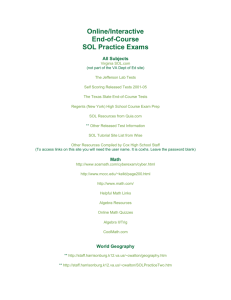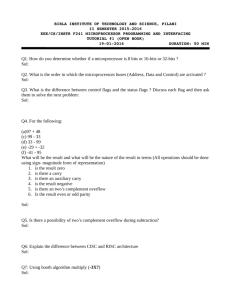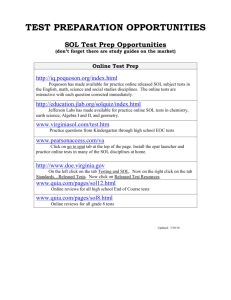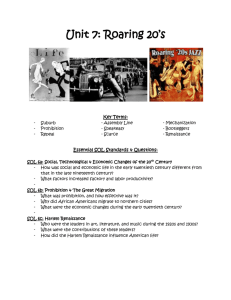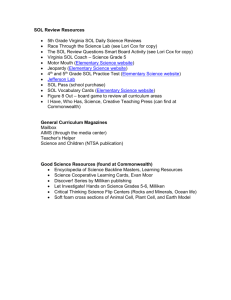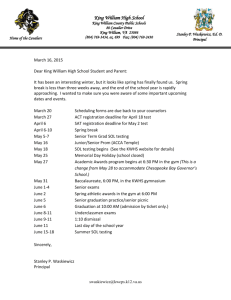Chapter 5. System Reliability and Reliability Prediction.
advertisement
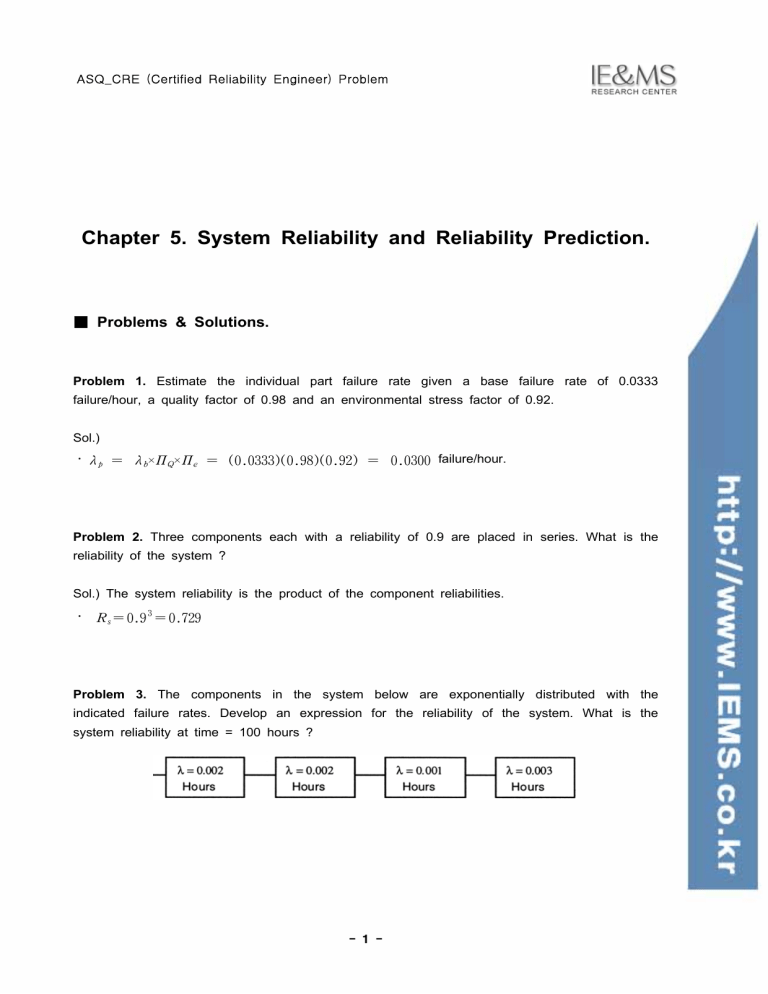
ASQ_CRE (Certified Reliability Engineer) Problem Chapter 5. System Reliability and Reliability Prediction. ■ Problems & Solutions. Problem 1. Estimate the individual part failure rate given a base failure rate of 0.0333 failure/hour, a quality factor of 0.98 and an environmental stress factor of 0.92. Sol.) ․ λ p = λ b×Π Q×Π e = ( 0.0333)( 0.98)( 0.92) = 0.0300 failure/hour. Problem 2. Three components each with a reliability of 0.9 are placed in series. What is the reliability of the system ? Sol.) The system reliability is the product of the component reliabilities. ․ R s = 0.9 3 = 0.729 Problem 3. The components in the system below are exponentially distributed with the indicated failure rates. Develop an expression for the reliability of the system. What is the system reliability at time = 100 hours ? - 1 - Chapter 5 : System Reliability. Sol.) For the exponential distribution, the reliability R(t) = e - The reliability of the system ․ R s (t) = ( e - 0.002t )( e - 0.002t )( e - 0.001t )( e - 0.003t - λt ) = e - 0.008t - The hazard function ․ λ s = 0.002 + 0.002 + 0.001 + 0003 = 0.008 - At time = 100 hours, the reliability is ․ Rs = e - 0.008( 10 0) = 0.4493 Problem 4. A home computer has two 3.5 inch disk drives. What is the probability of the computer operating successfully (with at least one disk drive) for 1000 hours. Assume the following estimated reliability values of the components. (where R(t) = e Component 3.5 inch Disk Drive - λt Failure Rate Reliability (1000 hours) 39/106 hr. .962 Hard Drive 6 34/10 hr. .967 CPU Board 4/106 hr. .996 Key board 10/106 hr. .990 Monitor ) 6 10/10 hr. - 2 - .990 ASQ_CRE (Certified Reliability Engineer) Problem Sol.) Parrel/Series Systems - The combination of the two disk drive ․R DiskDrives = 1 - ( 1 - 0.962)×( 1 - 0.962) = 0.9986 - The reduced parallel/series model - The reliability of the home computer at 1000 time ․ R s = .9986 × .967 × .996 × .990 × .990 = 0.9426 Problem 5. A system consists of four components. If more than two of the components fail, the system fails. If the components have an exponential time-to-fail distribution with a failure rate of 0.000388, what is the reliability of the system at time = 300 ? What is the system mean time to fail ? Sol.) A 2-out-of-4 systems - The reliability of each component ․ R =e 0.000388(300) = 0.89 - The system reliability 4 ․ Rs= ∑ x=2 [ = ( 4x ) R x ( 1 - R) 4 - x 4! ( 0.89) 2 (1-0.89) 4 - 2 + ( 2!) ( 4 - 2)! ] [ 4! ( 0.89) 3 (1-0.89) 4 - 1 ( 3!) ( 4 - 3)! 4! ( 0.89) 4 (1-0.89) 4 - 4 = 0.995 ( 4!) ( 4 - 4)! - The system mean time to fail + [ ] 4 1 ․ θs = ∑ i = 2 i( 0.000388 ) .= 1 1 1 + + = 2792 2( 0.000388 ) 3( 0.000388 ) 4( 0.000388 ) - 3 - ] Chapter 5 : System Reliability. Problem 6. On an interplanetary probe, the system has five synchronous computers that analyze all other systems and compare the results among each other. For a launch take place, four out of five computers must agree on the system parameters. If all agree, the launch takes place. If one computer fails and four agree, the fifth computer is ignored and the launch occurs. If two computers fail to agree, the launch is scrubbed. The reliability of a computer is 0.995. What is the probability of a successful launch ? Sol.) In this case n = 5, k = 4 - Determination of the failure rate( λ ) at t = 1 ․ R(t)= e - λt , then 0.995 = e - λt , consequently, λ = 0.005 - Apply λ to the 4 of 5 general formula 5 n! ( e 0.05 ) ( 1 - e - 0.05 ) ∑ k = 4 k!( n - k)! ․ R( t = 1) = 4 5! 5! ( 0.995) 4 (1-0.995) + ( 0.995) 5 (1-0.995) 0 = 0.99975 4! 5! = Problem 7. There are two components that are identical in a parallel configuration where the second unit is in standby and will be activated only upon failure of the primary unit. The switching to the backup unit is considered certain. The failure rate for each component is 0.002 failures/hour. What is the reliability for 200 hours ? Sol.) ․ R( t = 200) = e - λt = e (1 + λt) - ( 0.002)( 200) (1 + ( 0.002)( 2 00)) = e - 4 - - 0.4 (1.4) = 0.93845 ASQ_CRE (Certified Reliability Engineer) Problem Problem 8. The primary unit has a failure rate of 0.001 failure/hour. The unit in standby has a failure rate of 0.002 failures/hour. If the reliability of the switch can be considered to be 1 (perfect). What is the reliability for 200 hours ? Sol.) ․ R( t) = e - λ 1t λ1 (e λ 2 -λ 1 + R( t = 200) = e - ( 0.001)( 200) + - λ 1t -e - λ2 t ) 0.001 (e 0.002 -0.001 - ( 0.001)( 200) -e - ( 0.002)( 200) ) = 0.967142 Problem 9. The failure rates for two units in a parallel configuration, where the secondary unit is on back up until switched on upon failure of the primary unit, are each 0.002 failures/hour and the switch reliability is 0.95 per operation. What is the reliability for 300 hours ? Sol.) ․ R( t = 300) = e - ( 0.002)( 3 00) (1 + ( 0.95) ( 0.002) ( 300)) = 0.861635 Problem 10. Using the values from the unequal failure rates, perfect switching situation of 0.001 failure/hour for the primary unit and 0.002 failures/hours for the secondary unit, along with a switch reliability of 0.95 per operation ; what is the reliability for 200 hours ? Sol.) ․ R( t = 200) = e - ( 0.001)( 2 00) +0.95 (e { 0.0020.001 -0.001 } = 0.959721 - 5 - - ( 0.001)( 200) -e - ( 0.002) ( 200) ) Chapter 5 : System Reliability. Problem 11. A shared load parallel system when both items are functioning has a failure rate of λ 1 = 0.001 failures/hour. If one of the items fails, the failure rate of the surviving unit increases to 0.0003 failures/hour. What is the reliability of this system for 50 hours ? Sol.) ․ R( t = 200) = e - ( 0.001)( 2 00) +0.95 (e { 0.0020.001 -0.001 } - ( 0.001)( 200) -e - ( 0.002) ( 200) ) = 0.959721 Problem 12. A shared load parallel system when both items are functioning has a failure rate of λ 1 = 0.0001 failures/hour. If one of the items fails, the failure rate of the surviving unit increases to 0.0003 failures/hour. What is the reliability of this system for 50 hours ? Sol.) ․ R( t = 50) = e - 2( 0.0001)( 50) + 2( 0.0001) (e { 2( 0.0001) -0.0003 } - ( 0.0003)( 50) -e - 2( 0.0001)( 50) ) = 0.99993 Problem 13. Three power supplier are configured in a standby redundant system with perfect switching. The failure rate for each of the power supplies is constant with a mean time between failures of 20,000 hours. What is the probability of the system failing in less than 100,000 hours ? Sol.) Standby redundant system with an exponential time-to=fail distribution ․ The system reliability : R( t) = e - 0.00005t 3-1 ∑ i=0 (0.00005t) i i! ․ The reliability at 100,000 hours : R( t = 100,000) = e -5 0 (5) i 51 52 -5 5 =e + + = 0.1247 ∑ 0! 1! 2! i = 0 i! 3-1 [ ] ․ The probability of a failure in less than 100,000 hours of operation : P( failure ) = 1 -0.1247 = 0.8753 - 6 - ASQ_CRE (Certified Reliability Engineer) Problem Problem 14. In the figure below, components 1 and 2 have exponential time-to-fail distributions with mean failure times of 66,667 hours and 100,000 hours respectively. The reliability of the switch is 0.95. What is the reliability of the system at 10,000 hours ? Sol.) Imperfect switching and two components system. - The system reliability : ․ R s (t) = e = e - λ at - + t 66,667 pλ (e λ b -λ a 0.95 + - λ at -e - λb t ) 1 ( 66,667 ) (e 1 - t 66,667 1 100,000 66,667 - The system reliability at time = 100,000 : ․ R s (t=10,000 ) = e - 0.15 - 2.85 ( e - 0.15 -e - 0.1 -e -t 100,000 ) ) = 0.9865 Problem 15. Two components with constant failure rates of 0.003 make up a standby redundant system. The device that transfers operation to the second component after failure of the first component has a constant failure rate of 0.0005. Determine the system reliability at time = 400. Sol.) Imperfect switching with failure rate λ s - The reliability of the system : ․ R s (t) = e - λt [ 1 + λλ ( 1 -e - λ st s - 0.0005 t ) = e - 0.003 t 1 + 0.003 ) ( 1 -e 0.005 ] [ - The reliability at time = 400 : ․ R s (t) = e - 1.2 [ 1 + 6( 1 - e - 0.2 )] = 0.6288 - 7 - ] Chapter 5 : System Reliability. Problem 16. Two cables support the load of a crane. The failure rate of each of the cables is constant at 0.0007 if both cables are operating properly. The failure rate increases to 0.006 after one cable fails. Determine the reliability at time = 200. Sol.) Load parallel systems. - The reliability of this system : ․ R s (x) = e = e - 2λ h x + 2( 0.0007) t 2λ h (e 2λ h -λ f + - λf x -e - 2 λh x 2( 0.0007) (e 2( 0.0007) -0.006 ) - 0.006 -e - 0.0007 ) - The reliability of system at time = 200 : ․ R s (t) = e - 0.28 -0.3043( e - 1.2 -e - 0.28 ) = 0.8941 Problem 17. A pump operates continuously with a mean time to fail of 200 hours that follows the exponential distribution. A second, identical pump is placed in standby redundancy, and the mean time to fail while the pump is inactive is 1,000 hours. The standby time to fail is also exponentially distributed. What is the mean time to fail for the system, and what is the system reliability at time = 300 hours ? Sol.) In case of failure of a component while it is in standby mode. - The system mean time to fail : 1 1 0.005 1 + = 366.7 0.005 0.001 0.001 0.005 + 0.001 - The system reliability at time = 300 hours : ( ․ MTTF = ․ R s (t) = = ( 1 + λλ )e -λt s e ( 1 + 0.005 0.001 ) - )( λ e λs - 0.005( 30 0) ) - (λ + λs) t - 0.005 e 0.001 - 8 - ( 0.005 + 0. 001)300 = 0.512 ASQ_CRE (Certified Reliability Engineer) Problem ■ Performance Check 1. What failure rate must each component of a series system have, so that the probability that the system operates beyond 1000 hours is 0.9917 ? A B C Assume that all three components are independent, operate simultaneously, and have identical constant failure rates. Ⅰ. 0.00278 per hour. Ⅱ. 2.78 × 10-6 per hour. Ⅲ. 2.78 × 10 -5 per hour. Ⅳ. 0.0287 per hour. A. I only B. II only C. III only D. IV only Sol.) This problem requires a straightforward calculation for the failure rate given the reliability for three components in series as shown on the below. ․ Rs = R component ․. 0.9917 = e 3 = e - 3× λ×1000 - 3λt (where at t = 1000) ․ λ = 2.78×10 - 6 per hour. A 2. Given components with the following reliabilities : A = 0.99, B = 0.98, C = 0.97. What is the reliability of the system on the left ? A. Rs = 0.9998 B. Rs = 0.9994 C. Rs = 0.99994 D. Rs = 0.999994 Sol.) ․ R s = 1 - ( F A ․F B․F C ) = 1 - ( 0.1 ․0.2․0.3) = 0.999994 - 9 - B C Chapter 5 : System Reliability. 3. The reliability of a complex system can best be improved by : A. Selecting system components objectively. B. Multiple system testing (> 15 systems). C. Well designed and executed preventive maintenance system. D. Including redundant concepts in design. 4. The process of dividing up or budgeting the final reliability goal among the subsystems is known as : Ⅰ. Reliability estimation. Ⅱ. Reliability prediction. Ⅲ. Reliability apportionment. A. I only B. I and III only C. II and III only D. III only Sol.) In complex systems, it may be necessary to first determine the reliability requirement for the entire system and then allocate (apportion) reliabilities for subsystems. Reliability estimation and reliability prediction do not effectively address the process in the question. Answer D is correct. 5. What is the reliability of a five component parallel system when the reliabilities of each component are 0.70 ? A. 0.9813 B. 0.9919 C. 0.1681 Sol.) ․ R s = 1- ( F 1 ․F 2․F 3․F 4․F 5 ) = 1 - 0.3 5 = 0.99757 - 10 - D. 0.9976 ASQ_CRE (Certified Reliability Engineer) Problem 6. A system has three components with reliability values A, B and C. The reliability of the system, R, can be calculated using the equation : A. R = A + B + C B. R = A x B x C C. Insufficient information has been provided. D. R = 1 - [(1 - A)(1 - B)(1 - C)] 7. A non-repairable device that exhibits a history of failures consistent with a constant hazard rate, suddenly fails prematurely. Which of the options might be a possible cause for the failure ? A. Material fatigue caused by cyclic loading. B. Burn-in. C. Overload situation. D. Substandard manufacturing quality. Sol.) Material fatigue caused by cyclic loading will exhibit increasing probability of occurrence. Burn-in and substandard manufacturing will exhibit decreasing probability of occurrence. An overload situation is a random occurrence that will result in failures at a constant rate. Answer C is correct. 8. Develop a fault tree and analyze a car's headlight system whose failure could be caused by a battery failure (Pf=.18), broken wire (Pf=.07), or burned out head lamp (Pf=.30). What is the system's probability of failure ? A. 0.466 B. 0.480 C. 0.0038 D. 0.0042 Sol.) ․ Pf = 1 - (1 - 1.8)×(1 - 0.07)×(1 - 0.3) = 0.466 - 11 - Chapter 5 : System Reliability. 9. Which answer mathematically expresses the reliability of an active parallel system in which all component reliabilities are unequal ? A. Rs = Ra + Rb + Rc - RaRb - RbRc - RaRc + RaRbRc A B. Rs = (RaRbRc) / (Ra + Rb + Rc) C. Rs = Ra + Rb + Rc - RaRbRc B D. Rs = (RaRbRc - RaRb - RbRc - RaRc) / (Ra + Rb + Rc) C Sol.) ․ Rs = 1 - (1 - Ra)(1 - Rb)(1- Rc) = Ra + Rb + Rc - RaRb - RbRc - RaRc + RaRbRc 10. What is the reliability of the power switching system schematic on the left after 30,000 hours ? The electric utility primary power system (A) has a failure rate of 0.00001 failure/hour. The motor generator backup system (B) has a failure rate of 0.0007 failure/hour. The standby system has an imperfect switch with 0.90 reliability per operation. ※ Note : the schematic will disappear when the answer is displayed, you may want to take notes. A B A. 0.75 B. 0.80 C. 0.87 D. 0.83 Sol.) ․ R( t) = e - λ t + R sw 1 λ1 (λ 2 -λ 1 ) (e - λ1 t -e - λ 2t ) = 0.7505 - 12 - ASQ_CRE (Certified Reliability Engineer) Problem 11. What is the reliability for a device at t = 4 whose hazard function h(t) is on the below ? ꀊ0 ︳ ︳ ︳ ︳ ︳ ︳ ︳ ︳λ h( t) = ꀈ 2 ︳ ︳ λt ︳ ︳ ︳ ︳ ︳ ︳ 3 ꀖ λt t < 0 0 < t < 2 2 < t < 5 t ≥ 5 62 λ 3 Ⅰ. e - Ⅱ. e - 20λ Ⅲ. e - 22λ Ⅳ. e - 61 λ 3 A. I only B. II only C. III only Sol.) 4 ․ R(t) = e -⌠ ⌡ h(t) 0 = e ( 2 4 ⌠ 2 - ⌠ ⌡0 λdt + ⌡2 λt dt )=e - 62 λ 3 - 13 - D. IV only Chapter 5 : System Reliability. 12. Which process has as its principle parts : - Defining the system. - Establishing the reliability model. - Assigning failure rates to the equipment involved. - Computing the reliability for each function and for the system. A. Predicting reliability. B. Design review. C. Defining the program plan. C. Demonstrating the reliability. Sol.) Design review is the planned monitoring of a product design to assure that it will meet its express and implied performance requirements ; this activity occurs before the functions presented in the question. Defining the program plan includes activities for analyzing, apportioning, evaluating, planning, and testing ; these activities are too advanced for the functions in the question. Demonstrating reliability is evaluating the product's capability to meet the specified reliability. In analyzing the four answers, according to the reference sources, reliability prediction fits the question most accurately. Answer A is correct. 13. Failure rates in reliability analysis for the exponential case : A. Are multiplied together for independent events. B. Increase to the mean value and then decrease. C. Are summed to combine independent series elements in reliability analysis. D. Are used to model the Weibull when β = 2 Sol.) The reliability of system components in series are multiplied. Failure neither decrease nor increase exponentially. The Weibull distribution does not apply, it is pure filler. The reliability formula which includes the failure rate ( λ ) is on the below. If the system reliabilities are multiplied in the exponential case, they would appear as shown. That is mathematically equal to the sum of the exponents, or failure rates. ․ Rs = e - λ1 t × e - λ2 t = e - ( λ 1+ λ 2 )t - 14 - ASQ_CRE (Certified Reliability Engineer) Problem 14. What is the reliability of the logic diagram to the left ? R1 = 0.9 (Assume statistical independence of all 3 components) A. 0.9905 B. 0.994 C. 0.94 D. 0.996 R2 = 0.8 R3 = 0.7 Sol.) ․ R S = 1 -( 0.1 ․0.2․0.3) = 1 -0.06 = 0.994 15. The reliability expression for three independent components in series with component reliability R is? Ⅰ. 3R 2 Ⅱ. 3R - 3R + R 3 Ⅲ. (1 - R)3 Ⅳ. R3 A. I only. B. II only C. III only D. IV only 16. What is the reliability of the logic diagram on the left ? Where, R1 = 0.9, R2 = 0.8, R3 = 0.7, R4 = 0.6, R5 = 0.5, R6 = 0.4. Assume that each component is statistically independent. R3 = 0.7 A. 0.8201 R2 = 0.8 B. 0.7796 R4 = 0.6 C. 0.6918 D. 0.6803 R1 = 0.9 R5 = 0.5 R6 = 0.4 - 15 - Chapter 5 : System Reliability. 17. A system made up of 5 series components has a design reliability of .96. Subsequently, 4 of the components have reliabilities apportioned to them of .992, .991, .994, and .992. What should the reliability apportionment for the 5th subsystem be ? A. 0.970 B. 0.969 C. 0.990 D. 0.992 Sol.) ․ R s = R 1 ×R 2 ×R 3 ×R 4 ×R 5 ․ R5= Rs 0.96 = = 0.99034 R 1×R 2×R 3×R 4 ( 0.992)( 0 .991)( 0.994)( 0.992) 18. A system is made up of four independent components in series each having a failure rate of .005 failures per hour. If time to failure is exponential, then the reliability of the system at 10 hours is : A. 0.8187 B. 0.8860 C. 0.9512 D. 0.9802 Sol.) ․ Rt = e -λt = e - 0.005 ×10 = 0.95123 ․ R s = ( R t ) 4 = ( 0.95123) 4 = 0.8187 19. What is the reliability of the circuit on the below ? 0.9 0.9 A. 0.8439 B. 0.9068 0.9 0.9 0.9 0.9 0.9 C. 0.8029 - 16 - D. 0.8819 ASQ_CRE (Certified Reliability Engineer) Problem 20. The strength, X, of mechanical devices produced by a company follow a normal distribution with unknown mean and known variance = 36. Thirty of these devices were selected at random and tested to determine their strengths. Their average strength was 120. What is the maximum stress, x, that these devices should be exposed to so that, from this test data we can be 90% confident that P(X > x) = .95 ? A. 112.30 B. 108.73 C. 137.62 D. 127.71 Sol.) ․ x = 120, σ = 6, n = 30 ․ 90% confidence : x - z 0.1× σ n = 118.590 ․ 95% reliability : 118.590 - z 0.05 ×σ = 108.726 21. The reliability of a device comprised of various parts functioning in series is the : A. Product of the reliabilities. B. Sum of the probabilities of the unreliabilities. C. Product of the unreliabilities. D. Sum of the reliabilities. 22. Given components with the following reliabilities : A A = 0.99, B B = 0.98, C C = 0.97 What is the reliability of the system on the left ? A. Rs = 0.94 B. Rs = 0.97 C. Rs = 0.96 Sol.) ․ R s = 0.99×0.98×0.97 = 0.9411 - 17 - D. Rs = 0.93 Chapter 5 : System Reliability. 23. What component reliability is required to achieve a two component series system reliability of 0.998, if both components have the same reliability ? A. Rc = 0.99 B. Rc = 0.98 C. Rc = 0.998 D. Rc = 0.999 Sol.) ․ Rs = Rc 2 → Rc = R s = 0.999 24. Given mean-time-to-failure of 200 hours for each of two components, what is the probability of system failure if both components operate in parallel for one hour ? A. P = 0.010 B. P = 0.005 C. P = 0.001 D. P = 0.000025 Sol.) ․ R 1,2 (t= 1) =e - 1 200 = 0.995 ․ R s = 1 -F 1․F 2 = 0.999975 ․ F s = 1 - R s = 0.000025 25. If a component has a known constant failure rate of 0.0037 failures per hour; the reliability of two of these components in a series alignment would be : A. Insufficient information to solve problem. B. 99.63 percent. C. Less than 99 percent. D. Dependent on the wear out rate of a mating subsystem. - 18 - ASQ_CRE (Certified Reliability Engineer) Problem 26. Which is the most appropriate approach for calculating the total reliability of the system block diagram shown. (The system will function if either component I or II is operating). Ⅰ. Take the reliability for I and combine II with the reliability for III and then combine that result with the reliability for II Ⅱ. Take the reliability for III and combine it with the reliability for II and then combine that result with the reliability for I Ⅲ. Take the reliability for I and combine it with the reliability for II and then combine that result with the reliability for III Ⅳ. Multiply the reliabilities of I times II times III A. I only B. II only C. III only D. IV only Sol.) This question requires calculating the system reliability with both parallel and series components. From the choices given, only answer C is satisfactory. The reliability of the parallel components (Ⅰ and Ⅱ) is determined first, then combined with (multiplied by) the reliability of component Ⅲ to yield the system reliability. 27. Reliability prediction is : Ⅰ. A one time estimation process. Ⅱ. A continuous process starting with paper predictions. Ⅲ. More important than reliability attained in the field. A. I only B. II only C. III only D. I and III only Sol.) Reliability prediction is a continuous process which starts in the development phase (perhaps in the concept stage as well). It is updated throughout the development and operations phases. Reliability is more important than prediction, so option Ⅲ is incorrect. Answer B is correct. - 19 - Chapter 5 : System Reliability. 28. Reliability prediction is justifiable if : Ⅰ. It sets threshold tolerances for quality engineering planning. Ⅱ. It helps settle management's concern that a reliable product will be produced. Ⅲ. It leads to the development of a more reliable end product. Ⅳ. It is a contract requirement. A. I only B. II only C. III only D. IV only Sol.) Quality engineering planning is largely independent of reliability prediction and not a criteria for justifications. Prediction is not attainment, so it cannot address this concern. There is some merit to answer D, but the better objective is to produce a more reliable end product. Answer C is correct. 29. If the probability of a car starting on a sub-zero morning is 0.6, and we have two such cars. What is the probability that at least one of the cars will start on a sub-zero morning ? A. 0.92 B. 0.84 C. 0.81 Sol.) ․ R s = 1 - F A․F B = 1 - 0.16 = 0.84 - 20 - D. 0.60 ASQ_CRE (Certified Reliability Engineer) Problem 30. What is the predicted system reliability for the system on the left if each component reliability is .90 for the specified mission time and mission conditions ? R2 R1 R3 A. 72.9% B. 70.0% C. 89.1% D. 90.0% Sol.) ․ R 2,3 = 1 - ( F 1 ․F 3 ) = 0.99 ․ R s = 0.90×0.99 = 0.891 31. The design function which assigns probability of failures between components or subsystems is called : A. Significance. B. Prediction. C. Qualification. D. Apportionment. Sol.) The term which describes the assignment of the probability of failure among components is called apportionment (also allocation). The function assigning the component failure probability is also called apportionment or allocation. Prediction may be used in conjunction with apportionment, but it does not address the issues in this question. Significance and qualification are not applicable. Answer D is correct. - 21 - Chapter 5 : System Reliability. 32. A go/no-go device is tested until it fails. If x is the number of tests to first failure with no wear our present, and the probability of success on each test is .99, then the probability that x is greater than 5 is : A. 0.931 B. 0.941 C. 0.9510 D. 0.9610 Sol.) ․ P s = 0.99×0.99×0.99×0.99 = 0.9510 ․ P( x > 5) > 0.9510 33. Which of the following are valid failure causes used in reliability engineering ? Ⅰ. Static causes. Ⅱ. Brittleness. Ⅲ. Instability. Ⅳ. Creep. Ⅴ. Fatigue. A. II and III only B. II, III and IV only C. II, IV and V only D. I, II, III, IV and V 34. Which method is used to predict new device reliability during its early design stage ? A. Burn-in method. C. Parts count method. B. Part stress analysis method. D. Accelerated testing method. Sol.) Burn-in and accelerated testing are only applicable after the device has been built. The part stress method requires more detailed information and therefore is applicable later in the design phase. The parts count method is used in the easily phase. Answer C is correct. - 22 - ASQ_CRE (Certified Reliability Engineer) Problem 35. Which of the following models are used for software reliability ? Ⅰ. Basic execution time mode. Ⅱ. Markov analysis mode. Ⅲ. Logarithmic Poisson execution time model. Ⅳ. Simulation model. A. I and II only B. I, II and III only C. I and III only D. II, III and IV only Sol.) Markov analysis is used to model a system that can be defined as a set of states. Simulation modelling is used to validate and verify mathematical models. The basic execution time model and the logarithmic poisson execution time model are software reliability models. Answer C is correct. 36. What is this system's reliability at 3000 hours ? A B C D MTBFs for the components are : A=2500 hours. B=3700 hours. C=2000 hours. D=4000 hours. A. 0.017 B. 0.014 C. 0.047 - 23 - D. 0.029 Chapter 5 : System Reliability. 37. Develop the fault tree analysis for a candy dispensing machine. There are two contributing subsystems, both of them must fail for the system to fail. The electronic release has Pf = 0.04 and the coil spring release has Pf = 0.06. What is the system's probability of failure ? A. 0.0124 B. 0.0100 C. 0.0098 D. 0.0024 Sol.) ․ Pf = (0.04) (0.06) = 0.0024 38. What is this system's reliability at 700 hours ? A Component failure data is : Failure rate of A = 0.0007 failures/hr Reliability of B = 0.92 B MTTF of C = 1400 hours Reliability of D = 0.85. C A. 0.986 B. 0.998 C. 0.994 D. 0.952 D Sol.) ․ R A = e - 0.0007( 700) = 0.6126 ․ RC = e - 700 1400 = 0.6065 ․ R S = 1 - F A․F B․F C․F D . = 1 - ( 1 -0.6126)( 1 - 0.92)( 1 - 0.6065)( 1 - 0.85) = 1 - 0.001829 = 0.998 - 24 - ASQ_CRE (Certified Reliability Engineer) Problem 39. Which Boolean algebra expression is NOT correct ? A. 1 + 1 = 2 B. 1 × 1 = 1 C. 1 × 0 = 0 D. 1 + 0 = 1 Sol.) Boolean algebra is "logical algebra", based on logic operations. An "or" gate is symbolized by + and "and" gate is symbolized by ×. The correct, incorrect, answer is A. 40. What is the reliability of this system ? Where component reliabilities, A = 0.80 A. 0.10 B = 0.95 B. 0.90 C = 0.82 D = 0.85 C. 0.96 E = 0.75 D. 0.04 Sol.) ․ P(success if E is good) = (1 - (1-0.8)(1-0.95))×(1-(1-0.82)(1-0.85)) = 0.99 × 0.973 = 0.9633 ․ P(success if E is bad) = 1-[(1- (0.8 × 0.82))×(1-(0.95×0.85))] = 1 - [0.344×0.1925] = 0.9338 ․ Rs = (0.9633) (0.75) + (0.9338) (0.25) = 0.9555 - 25 - Chapter 5 : System Reliability. 41. A satellite has two redundant control systems, each has a failure rate (lambda) = 1×10-6 failures/hour. If one of the systems fails, the failure rate for the remaining system increases to 2×10-5 failures/hour. What is the reliability of the redundant control systems at 175,000 hours? A. 0.8609 B. 0.7493 C. 0.690 D. 0.2507 Sol.) ․ R( t) = e - 2λ t + 1 2λ 1 (2λ 1 -λ 2 ) (e - λ2 t -e - 2λ 1t ) = 0.7493 42. This system has perfect switching and equal failure rates of 0.007 failures/hour. What is its reliability at 50 hours ? A B A. 0.952 B. 0.950 C. 0.948 D. 0.013 Sol.) ․ R( t) = e -λt (1 + λt) = e - 0.007×50 (1 + ( 0.007× 50)) = 0.952 ( t = 50) 43. A redundant system has 5 standby parallel components, with perfect switching. If each of the components have a reliability of 0.03 failures/hour, what is the system's reliability at 20 hours ? A. 0.9232 B. 0.9432 C. 0.9997 D. 0.9999 Sol.) ․ R( t) = e -λt n (λt) i ∑ i! i=0 R( t =20) = e - 0.03×20 - 26 - 5 ∑ i= 0 (0.03×20) i i! = 0.9997 ASQ_CRE (Certified Reliability Engineer) Problem 44. Complex bridge reliability can be calculated using what methods ? Ⅰ. Stochastic probabilistic matrix. Ⅱ. Bayes theorem. Ⅲ. Boolean truth table. Ⅳ. Tie and cut sets. Ⅴ. Markov Analysis. A. I, II, III and V only B. I, II and III only C. II, III and IV only D. I, II, III, IV and V 45. A test sample of 50 tires are operated under simulated driving conditions to 20% tread depth. What is the 95% lower reliability limit for tread wear with a 90% level of confidence, if the tires exhibited a mean mileage to limit tread depth of 57,000 miles and a standard deviation of 8,000 miles ? A. 44,893 miles B. 42,392 miles C. 39,453 miles D. 41,622 miles Sol.) ․ Lower 90% confidence limit for the mean. XL = X-Zα σ n = 57,000 - ( 1.28) ( 8,000) 50 = 55,552 miles. ․ 95% lower limit for reliability. X 95 = X L - Z α․σ = 55,552 - 1.645( 8,000) = 42,392 miles. 46. A series system whose reliability at 5 hours is 0.80, has three components with these historical constant failure rates : λ 1 = failure rate for component 1 = 0.04 failures/hour. λ 2 = failure rate for component 2 = 0.07 failures/hour. λ 3 = failure rate for component 3 = 0.01 failures/hour. Three of the four answers are the three component reliabilities at 5 hours. Which is incorrect ? A. 0.9123 B. 0.9283 C. 0.8780 - 27 - D. 0.9816 Chapter 5 : System Reliability. Sol.) ․ Calculate system reliability R s : R(t= 5) = 80 = e λ s×5 , λ s = 0.0446 ․ Calculate weight w i : w1= 0.04 0.04 + 0.07 + 0.01 = 0.333 w2= 0.07 0.04 + 0.07 + 0.01 = 0.5833 w3= 0.01 0.04 + 0.07 + 0.01 = 0.0833 ․ Calculate component failure rate using ARINC apportionment technique. λ 1 = w 1․λ s = ( 0.3333) ․( 0.0446) = 0.014876 λ 2 = w 2․λ s = ( 0.5833) ․( 0.0446) = 0.02063 λ 3 = w 3․λ s = ( 0.0833) ․( 0.0446) = 0.003718 ․ Calculate component Reliability. R1 = e R2 = e R3 = e - λ1 t - λ2 t - λ3 t = e 0.014876×5 = 0.9283 = e 0.020630×5 = 0.8780 = e 0.003718×5 = 0.9816 47. Why is reliability prediction performed ? Ⅰ. To identify and predict safety issues. Ⅱ. To determine the estimated life of the device. Ⅲ. To identify the weakest component of the system. Ⅳ. To predict sales revenue in order to set the development budget. A. I, II and IV only B. II, III and IV only C. I, II and III only D. I, II, III and IV - 28 - ASQ_CRE (Certified Reliability Engineer) Problem Sol.) Reliability prediction is performed to identify and predict safety issues, determine the estimated life of the device, and identify the weakest component of the system. Sales revenue projections are not usually developed from predicted reliability data. Answer C is correct. 48. An exclusive "or" gate produces an output only if : A. All of the input events occur simultaneously. B. One, but not both input events occur. C. Any one of the input events occur. D. All of the input events occur in the correct order. Sol.) An "and" gate produces an output when all of the input events occur simultaneously. An "or" gate produces an output when any one of the input events occur. A priority "and" gate produces an output when all of the input events occur in the correct order. However, an exclusive "or" gate produces an output only if one, but not both input events occur. Answer B is correct. - 29 -

